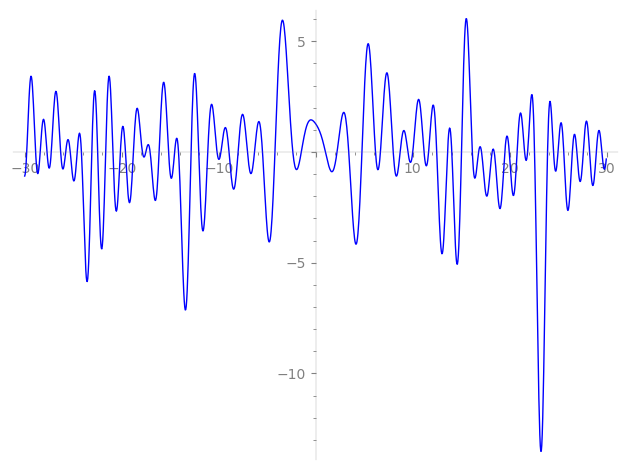| L(s) = 1 | + (−1.29 + 0.563i)2-s + (1.36 − 1.46i)4-s + (2.18 + 0.496i)5-s + 0.862·7-s + (−0.949 + 2.66i)8-s + (−3.10 + 0.583i)10-s + (4.00 + 4.00i)11-s + (−1.17 − 1.17i)13-s + (−1.11 + 0.485i)14-s + (−0.267 − 3.99i)16-s + 3.66i·17-s + (−0.732 + 0.732i)19-s + (3.70 − 2.50i)20-s + (−7.44 − 2.93i)22-s − 4.97·23-s + ⋯ |
| L(s) = 1 | + (−0.917 + 0.398i)2-s + (0.683 − 0.730i)4-s + (0.975 + 0.221i)5-s + 0.325·7-s + (−0.335 + 0.941i)8-s + (−0.982 + 0.184i)10-s + (1.20 + 1.20i)11-s + (−0.326 − 0.326i)13-s + (−0.298 + 0.129i)14-s + (−0.0669 − 0.997i)16-s + 0.888i·17-s + (−0.167 + 0.167i)19-s + (0.828 − 0.560i)20-s + (−1.58 − 0.626i)22-s − 1.03·23-s + ⋯ |
\[\begin{aligned}\Lambda(s)=\mathstrut & 720 ^{s/2} \, \Gamma_{\C}(s) \, L(s)\cr =\mathstrut & (0.522 - 0.852i)\, \overline{\Lambda}(2-s) \end{aligned}\]
\[\begin{aligned}\Lambda(s)=\mathstrut & 720 ^{s/2} \, \Gamma_{\C}(s+1/2) \, L(s)\cr =\mathstrut & (0.522 - 0.852i)\, \overline{\Lambda}(1-s) \end{aligned}\]
Particular Values
| \(L(1)\) |
\(\approx\) |
\(1.10957 + 0.621608i\) |
| \(L(\frac12)\) |
\(\approx\) |
\(1.10957 + 0.621608i\) |
| \(L(\frac{3}{2})\) |
|
not available |
| \(L(1)\) |
|
not available |
\(L(s) = \displaystyle \prod_{p} F_p(p^{-s})^{-1} \)
| $p$ | $F_p(T)$ |
|---|
| bad | 2 | \( 1 + (1.29 - 0.563i)T \) |
| 3 | \( 1 \) |
| 5 | \( 1 + (-2.18 - 0.496i)T \) |
| good | 7 | \( 1 - 0.862T + 7T^{2} \) |
| 11 | \( 1 + (-4.00 - 4.00i)T + 11iT^{2} \) |
| 13 | \( 1 + (1.17 + 1.17i)T + 13iT^{2} \) |
| 17 | \( 1 - 3.66iT - 17T^{2} \) |
| 19 | \( 1 + (0.732 - 0.732i)T - 19iT^{2} \) |
| 23 | \( 1 + 4.97T + 23T^{2} \) |
| 29 | \( 1 + (-0.253 + 0.253i)T - 29iT^{2} \) |
| 31 | \( 1 - 3.39T + 31T^{2} \) |
| 37 | \( 1 + (-5.48 + 5.48i)T - 37iT^{2} \) |
| 41 | \( 1 + 9.27iT - 41T^{2} \) |
| 43 | \( 1 + (2.43 - 2.43i)T - 43iT^{2} \) |
| 47 | \( 1 - 6.79iT - 47T^{2} \) |
| 53 | \( 1 + (-2.86 + 2.86i)T - 53iT^{2} \) |
| 59 | \( 1 + (-3.30 - 3.30i)T + 59iT^{2} \) |
| 61 | \( 1 + (3.44 - 3.44i)T - 61iT^{2} \) |
| 67 | \( 1 + (-8.23 - 8.23i)T + 67iT^{2} \) |
| 71 | \( 1 - 12.4iT - 71T^{2} \) |
| 73 | \( 1 - 11.5T + 73T^{2} \) |
| 79 | \( 1 - 0.0873T + 79T^{2} \) |
| 83 | \( 1 + (7.17 + 7.17i)T + 83iT^{2} \) |
| 89 | \( 1 + 5.86iT - 89T^{2} \) |
| 97 | \( 1 - 15.8iT - 97T^{2} \) |
| show more | |
| show less | |
\(L(s) = \displaystyle\prod_p \ \prod_{j=1}^{2} (1 - \alpha_{j,p}\, p^{-s})^{-1}\)
Imaginary part of the first few zeros on the critical line
−10.17142835923936472239044833020, −9.769330544984946988036330682400, −8.935941258689289447305353109191, −8.003615184525112457301752911849, −7.03847588735072023862290340061, −6.30866929618930936685062409987, −5.48569783416502284392745164792, −4.20387122289263256256246584276, −2.35924465259203173619270304027, −1.48591562055812201778573019288,
1.00011322644039807101735468566, 2.19697158760873932847590067245, 3.40346776783431756853721854241, 4.76278412353314993349133356837, 6.16222565755911037407467319759, 6.66878031634385042250731596473, 7.988951379079733074196454683269, 8.703473722789618638907321974186, 9.506928652430681113132276220578, 10.00046995298285424628261159445

